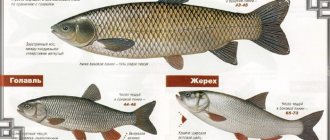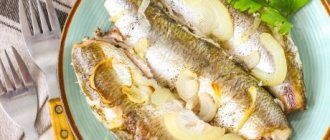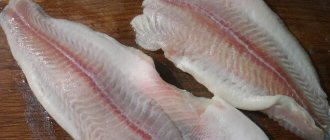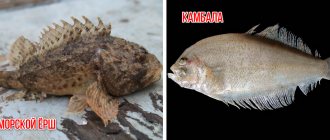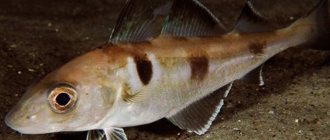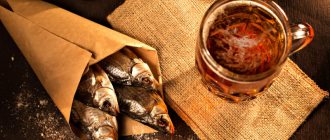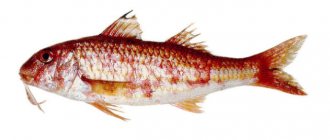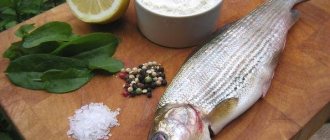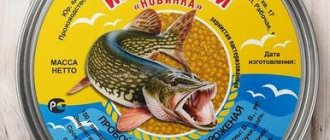Home / Plantation
Back
Published: 04/07/2020
Reading time: 14 min
0
18
- 1 Preparation
- 2 How to properly remove caviar from fish
- 3 Frying
- 4 How to pickle ide caviar at home
- 5 Serve
- 6 Asp caviar at home - it’s not difficult at all! 6.1 Fried caviar
- 6.2 Pickled caviar
- 13.1 Fried ide caviar
Preparation
First of all, clean the asp from scales and gut it. To prevent the meat from becoming bitter, cut off the fins or remove the head completely. Rinse the fish thoroughly under cold running water and dry with paper towels.
The next, perhaps the most important step is to make sure that the bones in the fish do not interfere with your enjoyment of the taste of fried asp. To do this, make shallow cuts crosswise on the sides of the prepared carcass. You should get a diamond-shaped pattern; it is thanks to them that the seeds will heat up during frying, become soft, and the small ones will completely dissolve.
How to properly remove caviar from fish
You can use caviar for salting only if the fish is fresh enough. To remove the caviar, you need to act very carefully and carefully. First we cut the belly of the fish. Then, with our fingers, we pick up the elongated shell bags with caviar and slowly separate them from the cavity of the fish.
It is very important to remove the caviar in one piece, since if handled carelessly, bitter bile may get into the caviar. Oysters are separate egg parts covered with a thin film, the internal filling of which plays a binding role for the eggs.
Frying
- Rub the fish ready for frying with salt and sprinkle with pepper. Set aside for 10-15 minutes, giving the asp a chance to absorb the spices.
- Dredge the carcass thoroughly in flour.
- Pour 2-3 tbsp into the pan. l. vegetable oil, heat it up.
- Carefully lay out the asp. Fry on both sides for 2-3 minutes over high heat until golden brown.
- Reduce heat to low, cover the pan with a lid, continue frying for another 7-8 minutes on one side, then the same on the other.
If desired, at the simmering stage you can add finely chopped onions and add 100-150 grams of sour cream. Both ingredients go well with fish, giving asp meat a particularly interesting aroma and taste.
How to pickle ide caviar at home
This is how unpresentable caviar looks after gutting the fish.
- We clean from film and blood.
Transfer the caviar into a saucepan.
- Take a sharp, thin, narrow and long knife.
- And, with quick cutting movements, we cut through all the joints. (Yastyk is a caviar sac taken from a fish)
- It turns out to be such a uniform mass.
- Now take another saucepan. It is more convenient when it has a slightly larger volume.
- Pour coarse rock salt into it, two heaped tablespoons.
- Mix and dissolve the salt in water, i.e. we get brine. (Brine is a saturated solution of table salt)
- Place the saucepan on the fire.
- Remove the brine from the heat and immediately pour it into the caviar.
- (This amount of brine and salt is used if you have up to a liter jar of caviar. If there is more caviar, multiply everything by 2.)
- It turns out to be caviar drenched in hot brine. This is what it looks like.
- We take a fork. And mix the caviar with quick circular movements for a couple of minutes.
- Now you need a fine strainer.
- Using a strainer, scoop the caviar out of the saucepan and transfer it to another container.
- As you can see, the brine remains cloudy and dirty after this.
- At this stage, you can leave some liquid in the caviar for now, i.e. do not wait until all the brine has drained through the strainer.
- Let's make brine again. (2 heaped tablespoons of salt, a liter of water, put it all on the fire and bring to a boil)
- Pour in the caviar again, mix and remove the films. They wrap easily around the fork. Those that do not wind up need to be removed one at a time.
- This is how many curled films are obtained from that amount of caviar.
- After the second filling with brine and removing the films, we get fairly clean caviar, all the eggs are separated.
- We make brine for the third time.
- Now the caviar looks very good, the brine remains clean and transparent after pouring and mixing.
- Now we again scoop up the caviar with a strainer and, each time, wait 1-2 minutes until the brine completely drains through the strainer.
- When all the brine has drained, place the caviar on a clean plate.
- When all the caviar is laid out, take a suitable sized jar and a small amount of sunflower.
Pour some oil into the bottom of the jar.
- Take caviar with a tablespoon.
- Now take fine salt.
- A small coffee spoon.
- And pour a little fine salt into the caviar.
- Mix fine salt with caviar.
- When all the caviar is placed in the jar, tamp it down with a spoon.
- Pour a little more oil on top.
- Now take the glass lid. If you don’t have such a lid, take a small saucer or a regular plastic lid. Cover the jar.
- And put the caviar in the refrigerator for several hours. I usually keep caviar in the refrigerator for 4-5 hours. During this time, the eggs swell, absorb salt and oil, and increase in volume.
After 5 hours you can do whatever you want - eat it with a spoon, spread it on sandwiches, treat your friends...
To enjoy delicious salted caviar, you don’t have to pay a lot of money for a small jar; you can pickle the caviar of crucian carp or any other river fish at home, and it’s very, very simple. I promise that after trying this recipe just once and appreciating it, you will often delight yourself with this delicacy. So, I’m telling you how to pickle caviar at home.
Ingredients:
- For every 100 gr. caviar:
- 7-9 gr. salt
- 1/2 tsp each 9% vinegar
- 1/2 tsp each vegetable oil
So, how to pickle caviar at home?
- First, we need fresh river fish - crucian carp or any other. It is advisable that the fish is still alive at the time of purchase, this is the only way you can be sure that they are selling you freshly caught fish, and not the catch of the day before yesterday.
- When the fish falls asleep and ceases to have a tail, cut the belly with a sharp knife and carefully remove the caviar. The caviar is kept in transparent “bags” called pressed caviar, which is why the caviar is called pressed caviar.
- So, in order to salt caviar, we need to get rid of the press and other films that are inside. There are different cleaning methods, but I will recommend the simplest, fastest and most effective.
- Place the caviar in a small bowl, then take a hand whisk and begin to “beat” the caviar. The films are wound on a broom. We periodically remove them and continue to beat until we collect all the films.
- This procedure takes very little time. Well, if you want to speed it up, you can use a blender with a broom attachment, minimum speed.
- After the caviar is cleared of films, transfer the caviar to a small glass jar.
- We either weigh the caviar on a kitchen scale, or calculate the weight by knowing the volume of the jar. I got 350 grams from two large crucian carp. peeled caviar.
- For every 100 gr. We put 7-9 grams of caviar. salt. To obtain lightly salted caviar for every 100 grams. add 1 level teaspoon of salt, for salty salt – a small heaped teaspoon.
- It is clear that after preparing salted caviar for the first time, you will taste the caviar and understand whether you need to adjust the amount of salt in the caviar next time or not.
- Mix the caviar, tie the jar with clean gauze and leave for 10 hours at room temperature.
- Then add 9% table vinegar to the caviar at the rate of 1/2 tsp. for every 100 gr. caviar.
- Quickly mix the caviar and put it in the refrigerator for 24 hours. Do not close the lid tightly; the caviar should “breathe”.
- After a day, add 1/2 tsp vegetable oil to the salted caviar. for every 100 gr. caviar. We use refined, odorless oil so that the caviar does not smell like oil. The oil should be fresh, without bitterness.
- Mix well and put the jar of salted caviar back in the refrigerator. After 2-3 days, the caviar acquires a beautiful red color, which indicates that the salted caviar is ripe and can already be eaten.
- That's all, you can make delicious sandwiches: spread butter on fresh bread, and top with a layer of caviar to taste.
We invite you to familiarize yourself with Cold smoked asp
Bon appetit!
This recipe features a special method of cleaning and washing the caviar.
For 2 kg. caviar you will need:
- water;
- salt;
- colander;
- several deep cups;
- gauze;
- large saucepan.
Preparation:
- Bring 5-8 liters of water to a boil and pour it over the caviar, previously placed in a deep cup. Try to get boiling water onto all the bags of caviar. Under the influence of hot water, the film moves away from the caviar and curls up. In this way, we will be able to quickly and efficiently release the eggs from the shell.
- It is important to pour the caviar quickly so that the water does not cool down. You can also clean the caviar from the film using a meat grinder - when scrolling, the entire film remains on the knife.
- Next, we get rid of small film residues. Pour plenty of cold water over the caviar and mix it thoroughly so that each caviar is thoroughly washed. We carry out the washing procedure 10-15 times, changing the water all the time until it becomes clear.
- Particular attention should be paid to the color of the caviar - it should be brick or bright orange. If it is dirty yellowish, it means that steaming was not enough and additional heat treatment is necessary. In this case, pour boiling water over the caviar again.
- After thorough washing, making sure that the caviar is clean enough, transfer it to dry gauze and tie it in a knot. To ensure complete drainage of water and easy drying, the unit can be hung.
- Next, your actions depend on how long you want to store the caviar. If you eat it in 1-2 weeks, then in 400-500 g of caviar it is enough to add a large pinch of salt and mix well. After it has stood in the refrigerator for 1 day, it can be eaten.
- For longer storage, the caviar bundle is soaked in brine. The brine is prepared from cold boiled water to which salt is added (5-6 liters of water and 7-8 tablespoons of salt are enough for 1.5 kg of caviar).
A gauze knot with caviar is dipped into this brine and kept there for 15 minutes. Then, to prevent the formation of salt, the caviar is washed once in a colander with cold water. After all the water has drained, the caviar is transferred to glass jars, closed with a lid and put in a cold place for storage.
Caviar from pike, roach, perch, carp, rudd, bream and crucian carp is ideal for salting. To prepare the appetizer we will need at least 150 grams of caviar.
The main preparatory stage is the release of the eggs from the film. This procedure is called "punching". Since we are working with a small amount of caviar, for these purposes you can use a colander, a sieve or a vegetable grater with non-sharp hole edges.
The larger the eggs, the larger the holes in the dish should be so that the eggs can pass through them freely. But the process of caviar cleansing is much faster if we use a colander.
The simplest recipe for salting caviar, known to all fishermen, is to place the caviar in a bowl, add salt, stir and let it sit for a while. After this, the caviar is considered ready for consumption. But do not forget that freshwater fish can be infected with various parasites, which will happily settle in the human body. And there are especially many of these parasites in fish caviar!
Therefore, eating caviar salted according to this recipe is very risky for health. Another disadvantage of this cooking method is the smell of fresh fish in the appetizer. To avoid all this, it is necessary to follow a special technology when salting, which will not only protect you from parasites, but also make the caviar very tasty.
First we need to prepare the brine. Rapa is a special salt solution for washing fish eggs.
- The proportions of standard brine are 100 g of salt per 1 liter of water. Bring the solution to a boil and pour the caviar into it while hot.
- Stir the caviar with a fork for about 3 minutes so that the hot solution covers all the eggs. Then we drain the brine and prepare a new one to repeat the procedure.
- A total of 3 fills are required. The first two times the water turns out cloudy, but the third time it should be more transparent and clean.
Then you need to free the caviar from excess moisture. To do this, put it on a sieve and wait 10-15 minutes until all the water has drained.
If there is no sieve, the caviar can be spread on a flat surface in an even layer of 3-4 cm and placed for a while at a slight slope. This method will help the water drain no worse than through a sieve.
Product calorie analysis
SHARE OF BZHU IN CALORIES
Ratio of proteins, fats and carbohydrates:
Knowing the contribution of proteins, fats and carbohydrates to calorie content, you can understand how well a product or diet meets the standards of a healthy diet or the requirements of a certain diet. For example, the US and Russian Departments of Health recommend 10-12% of calories come from protein, 30% from fat and 58-60% from carbohydrates. The Atkins diet recommends low carbohydrate intake, although other diets focus on low fat intake.
If more energy is expended than it is received, the body begins to use up fat reserves, and body weight decreases.
Try filling out your food diary right now without registration.
Find out your additional calorie expenditure for training and get updated recommendations absolutely free.
DATE FOR ACHIEVEMENT OF THE GOAL
Asp
rich in vitamins and minerals such as: choline - 13%, vitamin B5 - 15%, vitamin B12 - 51%, vitamin D - 247%, phosphorus - 27.5%, selenium - 22.9%, zinc - 12.3 %
- Choline
is part of lecithin, plays a role in the synthesis and metabolism of phospholipids in the liver, is a source of free methyl groups, and acts as a lipotropic factor. - Vitamin B5
is involved in protein, fat, carbohydrate metabolism, cholesterol metabolism, the synthesis of a number of hormones, hemoglobin, promotes the absorption of amino acids and sugars in the intestines, and supports the function of the adrenal cortex. A lack of pantothenic acid can lead to damage to the skin and mucous membranes. - Vitamin B12
plays an important role in the metabolism and transformation of amino acids. Folate and vitamin B12 are interconnected vitamins that are involved in hematopoiesis. A lack of vitamin B12 leads to the development of partial or secondary folate deficiency, as well as anemia, leukopenia, and thrombocytopenia. - Vitamin D
maintains calcium and phosphorus homeostasis and carries out the processes of bone tissue mineralization. A lack of vitamin D leads to impaired metabolism of calcium and phosphorus in the bones, increased demineralization of bone tissue, which leads to an increased risk of developing osteoporosis. - Phosphorus
takes part in many physiological processes, including energy metabolism, regulates acid-base balance, is part of phospholipids, nucleotides and nucleic acids, and is necessary for the mineralization of bones and teeth. Deficiency leads to anorexia, anemia, and rickets. - Selenium
is an essential element of the antioxidant defense system of the human body, has an immunomodulatory effect, and is involved in the regulation of the action of thyroid hormones. Deficiency leads to Kashin-Beck disease (osteoarthritis with multiple deformities of the joints, spine and limbs), Keshan disease (endemic myocardiopathy), and hereditary thrombasthenia. - Zinc
is part of more than 300 enzymes and is involved in the processes of synthesis and breakdown of carbohydrates, proteins, fats, nucleic acids and in the regulation of the expression of a number of genes. Insufficient consumption leads to anemia, secondary immunodeficiency, liver cirrhosis, sexual dysfunction, and the presence of fetal malformations. Research in recent years has revealed the ability of high doses of zinc to disrupt the absorption of copper and thereby contribute to the development of anemia.
more hide
You can see the complete directory of the most useful products in the appendix - a set of properties of a food product, the presence of which satisfies a person’s physiological needs for the necessary substances and energy.
Vitamins
, organic substances required in small quantities in the diet of both humans and most vertebrates. Vitamin synthesis is usually carried out by plants, not animals. A person's daily requirement for vitamins is only a few milligrams or micrograms. Unlike inorganic substances, vitamins are destroyed by strong heat. Many vitamins are unstable and are “lost” during cooking or food processing.
Description
Asp
- a minor commercial fish of the carp family. The average body length is from 60 to 80 cm, weighs 2-4 kg, occasionally 10-12 kg. Distributed in the basins of the North, Baltic, Black, Caspian, and Aral seas.
Asp
prefers rivers and is also found in lakes and desalinated parts of the sea. In the lower reaches of some southern rivers it leads a semi-anadromous lifestyle: in the spring it enters the rivers to reproduce, in the summer it feeds in the desalinated parts of the sea, and in the winter it lies down at the mouth “in pits”. Matures at 3-5 years. Spawning in April-May, usually on rocky ground, in places with fast currents. Lays from 40 thousand to 300 thousand eggs. The juveniles feed on crustaceans and bottom invertebrates; the adult asp is a predator.
This cautious riding fish, fortunately, every year more and more masters the breaker jets and wide reaches of reservoirs near Moscow. Asp has now become not just an ordinary fish for the Moscow region, but even one that is predominant in number over many other predators.
Asp: Useful properties.
The benefits of asp are manifested primarily in the high content of various vitamins, minerals and nutrients that are absolutely necessary for the human body. The beneficial properties of asp are due to the content of vitamin B1, which is absolutely irreplaceable if a person has to deal with great mental and physical stress for a long time. The benefits of asp are known all over the world, which is why it is so often used in culinary arts; a variety of dishes are made from it, which are not only healthy, but also very tasty.
The beneficial properties of asp help strengthen the body, which is often subject to psycho-emotional stress, tachycardia, edema and much more. The above-mentioned vitamin B1, which is contained in large quantities in asp, promotes the rapid healing of wounds, burns and ulcers. In addition, asp contains a huge amount of phosphorus and calcium, which makes dishes made from it an excellent source of vitality. These two elements help the proper formation of the skeleton and maintain the musculoskeletal system in good condition. Potassium contained in asp helps the heart muscle work, which is also very important for humans. The calorie content of asp is low, so dieters can eat it without worry.
Asp: Harmful properties.
If you have an individual intolerance to fish or have had allergic reactions, then the harm of the asp may manifest itself in this, so treat the fish with caution.
Posting ads is free and no registration is required. But there is pre-moderation of ads.
Asp is the fish that can be found in the waters of large rivers in Russia. This fish is considered predatory, but it belongs to the carp family. The asp begins his hunt at the age of two years.
This type of fish is quite large. It has a short but thick body. Her back is blue and shimmers with grey. The scales of this fish are quite large.
This fish gains weight and grows very quickly. In just one year, an asp can reach 28 cm in length, and its weight will be about 200 grams. By about three years, the fish reaches 1.5 kg in weight. To catch large fish, fishermen go to large rivers - only in large bodies of water will it be possible to catch large fish. In nature, there is even a so-called trophy asp - this fish can weigh up to 11 kg and have a body length of about 80 cm.
The asp can feed not only on other fish, but also on all kinds of insects, for example, grasshoppers or beetles. If the fish is not yet two or three years old, then it can only eat small mollusks and various crustaceans. To catch larger fish, you need to go fishing in the fall. At this time of year, the fish are trying to store more fat for the winter and hunt a lot. It is at this moment that you need to catch her.
The female lays about 100 thousand eggs at a time. After this, the fish becomes very weak and needs a lot of time to recover. The average lifespan of an asp is approximately ten years.
This fish contains a large amount of vitamin B1. Asp also contains calcium and phosphorus. This fish contains a little vitamin, a large amount of vitamin PP and H. The fish contains a lot of protein and saturated fatty acids. Asp also contains lysine, methionine, tryptophan and valine.
Serving
Both fried caviar and the asp itself are complete independent dishes, but in addition they go perfectly with any traditional side dish: cereals, vegetables, herbs. Therefore, you can easily serve a tasty and beautiful dish to the table, for example, by decorating the fish with lemon slices, pouring over any favorite sauce, and sprinkling with fresh herbs.
Simple manipulations, a minimum of ingredients, and here on the table is a ready-made excellent hot dish - fried asp, bon appetit!
Contraindications and harm
The main and main contraindications to eating asp dishes still remain:
- Individual intolerance to fish products;
- The occurrence of allergic reactions to fish.
However, due to the freshwater nature of the asp, helminth infection remains a dangerous factor. Therefore, it is not recommended to purchase the product “from hand”, but to take a proven (regarding the certificate information) fish product. How to cook balyk from asp in the Fishing School video
Asp caviar at home is not difficult at all!
If river fish caviar has to be salted frequently, special devices are made. For example, protruding carnations are stuffed onto a smooth round stick. Then the stick is dipped into the caviar mass and rotated. The film is screwed onto nails.
You can separate it by hand, but the shell sticks to your hands. You cannot wet it with water, as moisture gets into the eggs, the eggs swell and burst.
Having cleared the caviar mass of films, it is quickly washed with cold water, removing defective eggs, film residues and other impurities.
They prepare strong brine. For 100 g of caviar there are about 120 g of salt. You may need more salt, depending on its quality. Brine is a brine of such strength that an egg, potato, or onion does not sink in it.
The volume of brine after boiling should be three times the volume of the caviar mass. Therefore, water is taken with a small reserve.
Bring the water to a boil, add salt in small portions and stir. The brine is boiled for 10–15 minutes. If you pour boiling brine over ide caviar, it will be hard. Therefore, the solution is cooled. Pour in the caviar mass when the temperature drops to 40°. Keep for at least 10–15 minutes, stirring regularly so that all the eggs absorb the salt.
To improve the taste of salted caviar, shortly before removing from the heat, add the following to the brine:
- bay leaves,
- a pinch of ground pepper and peas,
- mashed coriander seeds and other spices,
- finely chopped garlic, 2-3 cloves.
You can experiment with spices and find out which of them will make salted ide caviar tastier. But additives should not overshadow the natural taste of caviar.
We invite you to familiarize yourself with Zamioculcas care at home, photos, transplantation, reproduction, turns yellow
You can immediately remove the mass from the brine and eat it if there is not much caviar. Squeeze it lightly, add chopped onion and vegetable oil. Salted caviar can be served at the table in the form of sandwiches or stuffed eggs (caviar is mixed with the yolk, placed instead of the yolk, or laid out in a heap on halves of eggs).
Any salted caviar is delicious with hot potatoes.
It is healthier and safer to pour fresh brine into the caviar twice or three times, dividing it into calculated portions. Double or triple treatment is guaranteed to destroy parasites living on river fish and their eggs. Keep the fish in each portion of the hot solution for at least 5–7 minutes.
For long-term storage, ide caviar is left for a day to ripen. It is hung in a linen bag and the remaining brine is allowed to drain naturally. Then they are laid out in jars that have been previously scalded with boiling brine. All utensils and tools used for rubbing and stirring caviar are processed in the same way.
Safety is guaranteed for a month. Usually, salted caviar is stored by covering the top with parchment moistened with vegetable oil. Or cover the surface of the caviar with oil: pour 2 tbsp on top. spoons.
Various dishes are prepared from river fish caviar. Most often, caviar is salted and fried.
Fried caviar
1. The simplest dish made from asp caviar is frying. The carcasses are gutted, the caviar is carefully removed, trying to leave the film intact. Wash, dry, let it lie open for a while. Lightly salt, maybe a little pepper. Other spices are unnecessary. Fry asp caviar for 3-4 minutes on both sides in a hot frying pan, adding a little butter.
2. Fry several finely chopped onions, add a mass of grated caviar, cleared of films. Fry, stirring continuously, until all the eggs are cooked. During frying, they change color and their orange color indicates readiness.
When gutting the fish, did the film break and the eggs fall out?
Suitable for cutlets or pancakes.
For 500 g of caviar you need:
- Raw eggs - 2-3 pcs.
- Onion - 2 pcs.
- Flour (semolina) - 5-6 tbsp. l.
- Salt, pepper, spices - to taste.
Pickled caviar
1 kg of caviar is twisted twice through a meat grinder. The onion is added a second time. The resulting puree is salted, pour in 1 tbsp. l. bite, stir. Leave to marinate for 2 hours.
Fish roe dishes as a list of recipes
Wondering how to cook fish caviar?
Below is a list of fish caviar dishes that are easy to view on our website; you just need to click on the link and go to the page with a detailed description of the preparation. For the convenience of readers, the list of fish, from the caviar of which delicious dishes are prepared, is given in alphabetical order. If you caught a good fish with caviar or purchased a package of caviar in a store, find “yours” in the list of fish and see what delicious things you can make from its caviar.
https://www.youtube.com/watch?v=ehYeLbN4O08
Asp soup
Methods for cooking delicious fish soup. Options for clarifying broth with fish caviar. Correct infusion so that the guy lies on the bottom, and the ear is light and transparent, beautiful to look at. Cooking recipes:
- Golden ear made from heads and pieces of pulp with butter.
- Ear soup made from heads alone with onions, carrots, potatoes, and herbs.
Fried asp
How to cook asp dishes - ingredients and preparation:
- Asp fried in egg-milk mixture and breadcrumbs
- Pre-marinated fish covered with garlic.
- Roasted in foil, buried in the burnt coals of the fire.
- Fried asp marinated in white wine without spices.
Asp in the oven
Ingredients for cooking asp in the oven: 2 fish, regular butter, onions or leeks, fresh tomatoes, herbs (preferably dill), vinegar, sour cream or sugar-free yogurt - 4-5 medium-sized pieces. Suitable spices include: paprika, hot and black pepper (you can add white pepper), laurel, marjoram, and salt.
Asp in foil
Asp - recipes for preparing fish baked in foil, in the form of pieces or whole carcasses, marinated and stuffed:
- Baking in the form of individual pieces laid out on foil.
- Fish stuffed with chilled lemon butter and dill and soaked rice, which swells in water for 15 minutes.
Asp cutlets
How to cook delicious fish cutlets. What additives are usually used to prepare river fish cutlets? Recipes:
- With fresh lard, which is added to the minced meat for fat content.
- With pre-soaked bread, onions and spices.
- With the addition of minced meat in a 1:1 ratio to fish.
Asp shashlik
Asp dishes are shish kebab, traditionally cooked on skewers over charcoal. The main stages of preparing shish kebab. Pre-marination of fish, suitable products, sauces and spices for marinade. Options for preparing different marinades. Recipe for a dish with a delicate white wine marinade.
Balyk from asp
Proper balyking of fish and preparing carcasses for balyking - cutting asps to prepare tender balyk. Layering is the process of carefully removing meat in one layer. Salting in different ways - dry, in brine. Optimal conditions for drying and drying. Proper packaging of fish is the best conditions for storing balyks.
Heh from asp
Asp dishes, which are both appetizers and salads. General tips for preparing asp heh and recipes:
- With a long process of salting and marinating separately.
- Heh with Korean carrots and pouring boiling oil
- With soy sauce, bell pepper, garlic and onion.
Cold smoked asp
Description and photos of recipes for preparing asp using cold smoking while maintaining optimal smoke temperature. Tips on choosing firewood, wood chips, shavings, sawdust and placing fish in the smoking apparatus. Description of the preparation of smoked asp with pre-salting using dry, wet and mixed methods
We invite you to familiarize yourself with: Asp and chub in spring on a water-filled float
Dried asp
Asp - recipes for making dried fish. Preliminary preparation of carcasses for the drying process: cutting, salting, washing, soaking. Salting in two ways: dry and wet, with and without spices. Duration of salting and soaking. The most favorable conditions for drying. Checking the readiness and storing dried fish.
Asp caviar dishes
What can you cook from caviar at home - the most popular recipes:
- Caviar fried in oil at speed without anything or with vegetables.
- Ikryaniki (caviar pancakes) or pancakes made from caviar dough.
- Pickled or salted caviar for long-term storage. Preparing caviar and containers for salting. Storing canned caviar.
This page describes the asp. Recipes for preparing dishes from this and many other fish are in the “Fisherman’s Kitchen” section.
Good fishing online stores will allow you to purchase any fishing goods at competitive prices!
Almost everyone loves caviar, and not only gourmet caviar: black and red. You can also prepare delicious and healthy dishes from the caviar of the most common river fish (pike perch, perch, bream, roach). When choosing a product, you should take into account that you need to cook mature caviar (the eggs are clearly visible, like beads, and do not create a jelly-like mass).
For such a dish, in addition to caviar, you need an onion, salt, and black pepper. Fry caviar in vegetable oil.
The caviar must be freed from the film. To do this, you can simply squeeze it, and the eggs will be squeezed out of the film shell. You can pick them out with a knife or fork.
The onion is finely chopped and fried in well-heated oil, and then caviar seasoned with pepper and salt is added to it. Then the ingredients need to be mixed. The “lazy” cooking option involves frying the caviar first on one side, then on the other. But it is better to stir the contents of the pan all the time.
The readiness of the caviar is determined by the color change: it should turn golden-orange.
You can finish cooking here, or you can make an excellent spread for sandwiches from caviar. To do this, combine it (still hot) with butter and chopped herbs and knead well. Before preparing sandwiches, slices of dried bread should be rubbed with garlic.
Fried caviar (from pike, for example) can also be served with a side dish, or can serve as an independent appetizer.
If you have time and desire, you can prepare very unexpected dishes from caviar. For example, fry pancakes. For them, for half a kilo of caviar you need 1 egg, 2-3 tbsp. spoons of flour, salt and pepper. All ingredients are mixed and fried in a frying pan in heated oil, carefully pouring the mixture with a spoon (it turns out to be quite liquid).
A variation of this dish is caviar cutlets. For them, for half a kilo of caviar you need 2-3 eggs, 2 onions, flour or semolina - 5-6 tbsp. spoons
Finely chop the onion, mix all the ingredients, beat well with a fork or broom, salt and add pepper. The finished “minced meat” should sit for 20 minutes. Cutlets are fried in the same way as pancakes. It should be taken into account that caviar is not meat, it is fried quickly, and the cutlets can burn if they are left on the fire.
Caviar is very easily digestible and contains very rare substances that are beneficial to human health.
We suggest you read: How to assemble gear for asp and what to use to catch a powerful predator
Caviar dishes can be included in the diet menu.
Today, caviar is used not only to decorate traditional appetizers for the holiday table, but also to prepare first and second courses, sauces and baked goods. Do you want to please your family and friends with an unusual, interesting dish? An excellent solution would be to make caviar, the recipe for which is very simple and accessible to every housewife, especially if her husband is an avid fisherman.
What kind of dish is this? How to cook it correctly? What ingredients are suitable? This and much more will be discussed in today's article.
Ikryaniki are pancakes or small round cutlets made from fish roe. Eggs of river fish (crucian carp, carp, pike, etc.) are suitable for preparing this dish. The products are prepared easily and simply. They turn out appetizing, bright, with a beautiful blush, and most importantly, very tasty. The most popular are caviar pancakes made from carp caviar.
The main nuance in preparing the dish still exists. If you use only caviar, the finished pancakes will be denser. For this reason, housewives have come up with many different options: with sour cream, cream, mayonnaise, onions, cabbage, etc. It is these ingredients that will give the finished dish a delicate, juicy, soft taste.
The traditional option does not include the addition of emollients. The finished dish turns out a little tough.
Products:
- any caviar - 500 g;
- egg - 1 pc.;
- premium flour - 30 g;
- table salt;
- oil for frying.
Rinse the caviar thoroughly. Using a fork, carefully remove the films. Place the prepared eggs in a bowl where the pancake dough will be prepared.
Add salt, beat in the egg, flour and mix thoroughly until smooth. Cover and leave on the table for a quarter of an hour.
Place the frying pan on the stove, generously grease with vegetable oil and heat thoroughly. Using a large spoon, form into round shapes. Fry on both sides until golden brown. Serve with sour cream or any other sauce.
In the oven
Don't know how to surprise your guests? Serve caviar on the festive table in portioned plates made of heat-resistant glass. The originality, unusual taste and presentation of the dish will surprise many. Don't forget to make extra garlic or spinach sauce.
Products:
- any caviar - 0.6 kg;
- onion - 0.3 kg;
- table salt;
- ground black pepper;
- cold water - 60 ml.
Wash the caviar, remove films. Place the prepared ingredients in a deep bowl. Peel the onions, rinse and finely chop into cubes. Combine everything in one container, add salt and spices.
Mix thoroughly and leave for 10 minutes to completely dissolve. Stir everything again and grease the baking pans with oil. It is better to use cocotte makers. Spread the caviar mass.
Preheat the oven to a temperature of 220 degrees. Place the container on a baking sheet and bake for 25 to 45 minutes, depending on the volume of the container. Remove from the oven, place on a saucer and serve.
With cabbage
A more delicate and mild taste is obtained if you add a little white cabbage. The dish is served with any sauce: creamy, sour cream, with herbs, etc.
Products:
- any caviar - 0.4 kg;
- white cabbage - 270 g;
- onion - 100 g;
- egg - 1 pc.;
- premium flour - 30 g;
- frying oil;
- table salt;
- ground black pepper.
We suggest you familiarize yourself with: Spring asp fishing with spinning rods, suitable gear and tactics
Rinse under water, place in a large saucepan and stir with a fork. Remove films.
Peel the onion and chop into thin cubes. Combine with caviar, mixing thoroughly. Beat in the egg and proceed in a similar manner.
Rinse clean cabbage and chop into thin strips. Mash slightly so that the slices soften a little. Mix all ingredients, add salt and seasonings. Leave for 10-15 minutes.
How to pickle river fish caviar - for sandwiches
Bon appetit!
Before salting, the eggs are freed from the strong film.
The film removal process is carried out in different ways:
- Rub the eggs through a sieve.
- Using a sharp fishing knife (with a narrow blade), cut the films lengthwise, and carefully remove the caviar.
- Pass through a meat grinder.
- Beat the caviar with a fork (the film is wound around the fork, removed, and thrown away).
- Small cloves are stuffed onto one side of a round stick. The stick is lowered into the bowl with caviar and rotated. The film is wound and remains on the nails.
- Beat with a mixer.
- Pour boiling water over it. The film turns white, curls up, and is easily removed with a fork. Caviar will not be harmed by treatment with boiling water. Additionally disinfected.
Dry salting. Any salt is used, preferably fine. The caviar is crushed, the film is removed, salt and pepper to taste. After 20 minutes, asp caviar dishes are served, adding onions and vegetable oil. Or in the form of a pate, spread on bread covered with a layer of butter. How much salt is required so as not to spoil the product? Salt is added by eye. Taste after 10 minutes and add more if necessary.
Salting asp caviar in hot brine. Add salt to boiling water: 70-100 g of coarse salt for every liter of water. Allow the brine to cool to a temperature of 50-60° (your hand can handle it). Pour in the punched (cleaned from the film) caviar and let it sit for 10-15 minutes. Strain through cheesecloth. Then the caviar is suspended in this gauze and the remaining liquid is allowed to drain. As soon as the brine stops flowing, serve. The caviar is beautiful to look at, granular and large. It tastes good even without adding onions and butter.
How to pickle asp caviar in cold brine? They prepare strong brine. Dip a raw egg into the water, add salt little by little and stir. Stop adding salt when the egg floats. The caviar, cleared of film, is placed in a thick linen bag (stocking, gauze or cotton bag) and dipped into the solution for 10-15 minutes. Then they hang it up. When the water has drained and the fat begins to drip, the caviar is removed from the bag and prepared for serving or canning.
Gourmets claim that dry salting does not reveal the real taste of asp caviar. “Wet” salting in brine is preferable.
When serving, add chopped onion and a little garlic to the caviar - it makes an excellent appetizer. Caviar pate is spread on bread, half boiled eggs, and garlic croutons. Used for filling pancakes.
Asp caviar, salted in any way, is prepared at home for future use. It is placed in small screw-on jars and a thin layer of vegetable oil is poured on top. The oil film prevents air penetration and spoilage. The snack can be stored for several weeks.
To salt asp caviar for a long time, it is poured with boiling brine three times (100 g of salt per liter of water). If you use sterilized containers (jars, sieve, spoons), caviar, even under plastic covers, can be stored for months in the bottom of the refrigerator.
1. Pour in the caviar, stir for three minutes with a fork. Strain.
2. Pour in a new portion of the boiled solution. Stir again for 2-3 minutes, removing the film from the fork. Strain, remove the remaining small pieces of film (dark, curdled lumps).
3. For the third time, pour boiling solution over the caviar and stir. The solution remains light and transparent. Strain and leave on a sieve for 10-15 minutes to allow the remaining liquid to drain.

4. Pour 2 tbsp into the bottom of liter jars. l. vegetable oil. Fill the jars with caviar, add oil on top with a 0.5 mm layer. After two hours, the snack is ready to eat, but it is better to let it sit in the refrigerator overnight. Caviar does not smell like fish, it tastes delicate.
To ensure safety when laying out, add 1 tbsp to each jar. l. salt (fill 2/3 of the jar, add salt, mix, add jar to the top and add oil). Removed for long-term storage.
Asp caviar at home is always delicious!
Salting caviar
Salting caviar is as easy as preparing balyk. According to the recipe for a lightly salted dish, you will first need to remove the film; for this you can use a large sieve through which you can simply wipe it.
Then take 20 grams of salt, 10 grams of sugar per 100 grams of caviar and add it to sleep. If desired, you can use dry herbs or spices, but this will be unnecessary. Mix everything well, put it in a glass jar, close the lid and put it in the refrigerator for a day.
You can spread the product on bread with butter and enjoy its amazing taste.
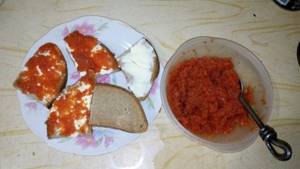
To learn how to pickle asp, watch the video below.
Tips and little tricks
- The fattier the fish, the tastier and healthier its caviar.
- It is better to use fine “Extra” salt for pickling.
- Spring caviar is most suitable for pickling. It is larger, more nutritious and can be stored for a very long time.
- Do not use metal utensils. The utensils for preparing caviar should be glass, porcelain, wood or clay.
- It is possible to salt even frozen caviar. For example, trout caviar, which is sold frozen.
- To determine the readiness of the salt brine, you can use raw peeled potatoes. Place the potatoes in the water and gradually add salt, stirring. As soon as the potatoes float to the surface, the brine is ready.
What does asp fish look like?
Asp fish is one of the most common fatty fish varieties from the asp genus and the carp family (order - cypriniformes). At different points of sale it is also called cherry, beleznaya, zherikh, belesti, sheresper or pike-shaped balder (however, the latter separate species is listed in the Red Book and therefore incorrectly belongs to the general freshwater category of asp).
In addition, the asp is considered a “serious” large fish, the length of which can be from 50 centimeters, and the weight is at least 3 kilograms. In some cases, fish up to 120 centimeters long and weighing about 12 kilograms have been recorded.
We invite you to familiarize yourself with the pinkish Rhizopogon (Rhizopogon roseolus) photo and description
In appearance, the fish is characterized by:
- Fusiform body of elongated type;
- Dark gray-blue back;
- Silver-gray sides;
- White belly;
- The presence of gray dorsal and caudal fins with darkish tips (although most often they are simply edged with a black border);
- Long lower tail;
- Red color of fins at their base;
- Gray tips of all fins;
- Slightly elongated head shape;
- Lower jaw slightly protruding upward;
- Toothless mouth.
Usually the fish stays solitary, but upon reaching puberty in the fifth year of life, it often gathers in small schools. The maximum age of the asp is 15 years of life. The main spawning period is considered to be the end of April and the beginning of May.
In this case, eggs are laid by females only in sandy-silty or rocky soil. True, at this time the fish becomes especially cautious and timid, weakens greatly, which is why it hides in deep places with a complete absence of current.
Where is the asp fish found?
Often, fish live in almost all large rivers that flow into the Black and Caspian Seas. But in the rivers of the Baltic and Azov seas this fish is more difficult to find. In Central Asia it can be found in the Syr Darya and Amu Darya rivers.
On European territory it is found in some rivers of Estonia, Lithuania, Germany, the Czech Republic, Poland, Bulgaria, Romania, Norway, Sweden, and Finland. It is believed to have reached Switzerland through the Rhine-Main-Danube Canal and further to Serbia, Croatia, Austria, Hungary and Slovakia.
Although the asp prefers freshwater rivers with slow currents, it can sometimes be found in lakes and reservoirs. Thus, one of the asp species was once introduced into the lakes near Baghdad for commercial fishing. In these reservoirs, fish lead a slightly different lifestyle than in rivers and live in schools.
Short description
The asp is considered a long-liver and can live up to 15 years. This is because by nature he is very cautious and has good reactions . It has many names for its characteristic hunting. One of these ancient names is sheresper. This is how they called him for his special hunt, during which he, jumping out of the water, spreads his fins.
The body of the fish is thick, elongated, slightly compressed at the sides, which is why it has a massive appearance. The average body length of a predator usually varies from 45 to 85 cm. The usual weight of the fish is 1.5−3 kg. But there have been cases where large specimens with a length of 125 cm and a weight of 13-14 kg were encountered, but such sizes are very rare .
It usually has a dark gray back, the sides are a little lighter, and the belly fades to white, sometimes with a yellowish tint. The fish is covered with large scales. The fins are gray with a reddish tint. The upper dorsal fin is thin and pointed. The tail fin is also gray, darkening at the edges. When the asp goes on a summer hunt , the fin of the back is often visible on the surface of the water.
Habitats
The sheresper fish lives in reservoirs with clean running water . You will not find it in dirty, stagnant waters of lakes and rivers. The predator loves deep, full-flowing and wide rivers, but, as a rule, stays closer to the surface of the reservoir. In the autumn, when strong winds blow and the rainy season begins, the asp goes into the depths. There at this time he feels safe.
Mainly lives in one territory. However, habitats may change over time. In cold winters it does not hunt and prefers deep holes. In the spring, when spawning ends, it is usually at medium depths with a slight current. In summer, it prefers to live closer to the surface of the water in shallow holes and riffles.
The sheresper's range extends from the Ural River to the Rhine River. The Rhine is a large and deep river that passes through several states . This type of fish can be found in Eastern and Western parts of Europe. But this fish is not found in the Far East, Siberia and the North Caucasus.
Features of predator hunting
At a young and young age, the sheresper prefers to hunt in a pack . It feeds on small crustaceans and bottom living creatures. As he grows older, he prefers a solitary lifestyle. But in some cases it does not hesitate to hunt in a pack.
This predator has its own special hunting method. Seeing its prey, the asp accelerates and jumps out of the water. When landing with a powerful blow of the tail on the surface of the water, it drowns out the prey. Then he quickly eats it and looks for another. This type of hunting is due to the fact that it has no teeth in its mouth. They are in the pharynx . And he has nothing with which to grab prey, as a pike does.
Spawning time
Spawning begins at 3-4 years of age. The time for spawning occurs in mid or late April. It depends on weather conditions. By the time of spawning, the aquatic environment warms up to 7-8 degrees. Caviar throwing occurs in groups divided into pairs. Each pair brings up to 100,000 eggs. The female lays eggs on thin branches, stems and roots of plants. The eggs, being very sticky, stick well to them.
After about two weeks, fry emerge from the eggs. Adults rest after spawning. Then they begin to actively eat, restoring strength. During this period, the predator is very exhausted and eats everything that is edible for it. Therefore, at this time it is not difficult to catch it. But even a caught asp resists , fighting back with its powerful tail.
What are the benefits of asp fish?
Asp is famous for its tasty and tender meat that melts in your mouth. But many consider it a high-calorie food that is prohibited for consumption during weight loss diets.
But this opinion is not entirely correct, because the meat of this fish contains:
- Protein fractions (proteins);
- Fats (no more than 3 g);
- Water;
- Ash products;
- A number of B vitamins (nicotinic acid, thiamine, riboflavin);
- Retinol (vitamin A);
- Provitamin A, or beta-carotene;
- Minerals represented by molybdenum, nickel, chromium, fluorine, chlorine, iron, potassium, phosphorus, magnesium, sodium, calcium.
The total calorie content of a fish product is about 99 kilocalories (even less than some vegetables).
The meat of this fish is not only tasty, but also healthy. Compared to other types of fish, it contains about 1 mg of vitamin C, one of nature's best antioxidants. That's quite a lot for a fish.
In addition, vitamin C has a positive effect on hormone synthesis, blood clotting and has an anti-inflammatory and antibacterial effect. Ascorbic acid reduces the risk of an allergic reaction, increases the body's resistance to adverse factors, and also promotes the rapid elimination of toxins.
Another vitamin found in fish meat is vitamin A. This vitamin helps regulate metabolism, has a positive effect on visual receptors and improves the condition of human skin.
Fish meat also contains vitamin PP or nicotinic acid. This vitamin is involved in oxidation and reduction reactions, hormone synthesis, improves blood circulation and helps get rid of toxins in the body.
Vitamin B1 is essential for the healing of wounds and burns. In addition, the body needs it during severe stress, tachycardia and shortness of breath.
Asp contains elements such as phosphorus, calcium, sodium, potassium, which are involved in the formation of the skeleton, prevent stress and have a positive effect on the cardiovascular system.
As already noted, fish meat is low in calories and contains many vitamins and minerals, so it can be considered for dietary nutrition.
Methods of eating asp
Culinary specialists fry, stew, bake, salt, smoke this fish, and also prepare minced fish from the pulp. Asp fish soup cooked over a fire in a cauldron is especially tasty.
Excessive bonyness is the only drawback of the meat of this predator. You can get rid of sharp and small bones by smoking or drying fish. Salted asp has excellent taste, and under the influence of salt the bones become soft and are practically not felt while eating. Balyk made from asp is no different in taste from salmon balyk.
Asp caviar also has commercial and nutritional value. It has an excellent delicate taste, a beautiful amber color, and contains many components valuable for the human body. Fish roe can be consumed freshly prepared.
Video from YouTube on the topic of the article:
Access to this page has been denied because we believe you are using automation tools to view the website.
This may happen as a result of:
- Javascript is disabled or blocked by an extension (such as ad blockers)
- Your browser does not support cookies
Make sure Javascript and cookies are enabled in your browser and you are not blocking them from loading.
Link ID: #f14be770-b276-11ea-a663-f1dfdc9f65d8
Fish and seafood provide our body with more easily digestible protein, unlike meat, and very valuable substances that are simply not found in meat. In terms of calorie content, fish also wins.
And even if some types of fish also contain a fairly large amount of fat, this is more of a plus than a minus. Because the elements they contain are of great importance for the healthy functioning of our body. The well-known acids omega-3 or omega-6 are just proof of this, and they simply are not found in meat.
Therefore, we study the plate with the composition and calorie content of fish, caviar and seafood and, if possible, consume these wonderful products as often as possible.
Table 2. Calorie content and composition of fish, caviar and seafood.
Access to this page has been denied because we believe you are using automation tools to view the website.
This may happen as a result of:
- Javascript is disabled or blocked by an extension (such as ad blockers)
- Your browser does not support cookies
Make sure Javascript and cookies are enabled in your browser and you are not blocking them from loading.
Link ID: #f4965780-b276-11ea-9769-9742b7b4cffc
A successful fisherman treats you not with stories, but with fish
Asp fish benefits
Active synthesis of adrenaline;
Production of hormones necessary for human life;
Regulation of capillary permeability;
Stabilization of blood clotting processes;
Reduced manifestations of allergic reactions;
Providing a general anti-inflammatory effect on the body;
Strengthening the immune system;
Better absorption of calcium and iron;
Strengthening bone tissue;
Removal of toxic substances such as mercury and lead;
Restoration and normalization of redox processes;
Strengthening capillary and small-vascular blood flow;
Strengthening the nervous system in general;
Improving the condition of the optic nerves and eye vessels;
Normalization of metabolic processes;
Maintaining the body under high physical and mental stress;
Removing swelling of any origin;
Increasing the level of stress resistance;
Relieving tachycardia and shortness of breath;
Improved digestion;
Stimulation of bile excretion;
Improving intestinal motility;
Increased appetite;
Preventing constipation;
Assistance in the treatment of non-healing wounds and burns;
Normalization of the heart muscle;
Strengthening general muscle activity;
Prevention of the development of cancer.
What to cook from asp fish
If you don’t like the taste of salted ide caviar, you don’t want to take risks or just bother with preparing brine; other dishes are prepared from caviar. They use caviar mass, cleared of films.
Fried ide caviar
Place caviar in a hot frying pan with vegetable oil poured on the bottom and fry until done, stirring frequently, until all the caviar is evenly fried. This can be seen by the color.
What you will need for 400-500 g of ide caviar or any other similar breed of fish:
- potatoes - 1 kg
- onion - 100 g
- sour cream - 1 tbsp. l.
- vegetable oil - 75 g
- salt - to taste
Separately, finely chopped onions and sliced potatoes are stewed in oil. Add sour cream to the caviar and mix. Next, mix potatoes, onions and caviar, place in a fireproof dish and bake in the oven until cooked.
Asp caviar
If during gutting you find caviar in the asp’s belly, do not rush to throw it away. Fried asp caviar is a real delicacy that all lovers of fish dishes should definitely try, and even people who don’t particularly like fish on their menu will be able to appreciate such an unusual dish.
When gutting fish, carefully remove the eggs, being careful not to damage the film. Rinse off any remaining discharge from the caviar and dry. Lightly salt and pepper; you should not use other spices, they will overwhelm the delicate taste of the delicacy. Place the caviar on hot butter in a frying pan and fry for 3-4 minutes on each side.
If the film breaks and the eggs scatter, don’t worry, you can make wonderful caviar pancakes: mix the caviar with salt, pepper, one egg white and a small amount of flour. Spoon the resulting mixture into well-heated vegetable oil, fry on both sides for 2 minutes each.
